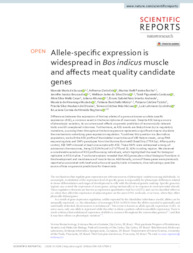Allele-specific expression is widespread in Bos indicus muscle and affects meat quality candidate genes.
Allele-specific expression is widespread in Bos indicus muscle and affects meat quality candidate genes.
Author(s): SOUZA, M. M. de; ZERLOTINI NETO, A.; ROCHA, M. I. P.; BRUSCADIN, J. J.; DINIZ, W. J. da S.; CARDOSO, T. F.; CESAR, A. S. M.; AFONSO, J.; ANDRADE, B. G. N.; MUDADU, M. de A.; MOKRY, F. B.; TIZIOTO, P. C.; OLIVEIRA, P. S. N. de; NICIURA, S. C. M.; COUTINHO, L. L.; REGITANO, L. C. de A.
Summary: Differences between the expression of the two alleles of a gene are known as allele-specific expression (ASE), a common event in the transcriptome of mammals. Despite ASE being a source of phenotypic variation, its occurrence and effects on genetic prediction of economically relevant traits are still unexplored in bovines. Furthermore, as ASE events are likely driven by cis-regulatory mutations, scanning them throughout the bovine genome represents a significant step to elucidate the mechanisms underlying gene expression regulation. To address this question in a Bos indicus population, we built the ASE profile of the skeletal muscle tissue of 190 Nelore steers, using RNA sequencing data and SNPs genotypes from the Illumina BovineHD BeadChip (770 K bp). After quality control, 820 SNPs showed at least one sample with ASE. These SNPs were widespread among all autosomal chromosomes, being 32.01% found in 3'UTR and 31.41% in coding regions. We observed a considerable variation of ASE profile among individuals, which highlighted the need for biological replicates in ASE studies. Functional analysis revealed that ASE genes play critical biological functions in the development and maintenance of muscle tissue. Additionally, some of these genes were previously reported as associated with beef production and quality traits in livestock, thus indicating a possible source of bias on genomic predictions for these traits.
Publication year: 2020
Types of publication: Journal article
Observation
Some of Embrapa's publications are published as ePub files. To read them, use or download one of the following free software options to your computer or mobile device. Android: Google Play Books; IOS: iBooks; Windows and Linux: Calibre.
Access other publications
Access the Agricultural Research Database (BDPA) to consult Embrapa's full library collection and records.
Visit Embrapa Bookstore to purchase books and other publications sold by Embrapa.

